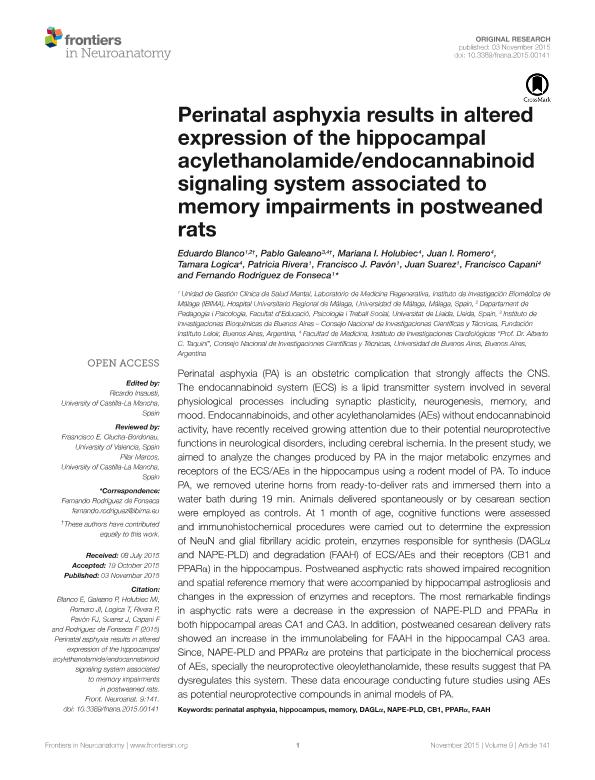Mostrar el registro sencillo del ítem
dc.contributor.author
Blanco, Eduardo
dc.contributor.author
Galeano, Pablo

dc.contributor.author
Holubiec, Mariana I
dc.contributor.author
Romero, Juan Ignacio

dc.contributor.author
Logica, Tamara
dc.contributor.author
Rivera, Patricia
dc.contributor.author
Pavón, Francisco J
dc.contributor.author
Suárez, Juan
dc.contributor.author
Capani, Francisco

dc.contributor.author
Rodríguez de Fonseca, Fernando
dc.date.available
2016-12-20T20:48:56Z
dc.date.issued
2015-11
dc.identifier.citation
Blanco, Eduardo; Galeano, Pablo; Holubiec, Mariana I; Romero, Juan Ignacio; Logica, Tamara; et al.; Perinatal asphyxia results in altered expression of the hippocampal acylethanolamide/endocannabinoid signaling system associated to memory impairments in postweaned rats; Frontiers Research Foundation; Frontiers in Neuroanatomy; 9; 11-2015; 1-16
dc.identifier.issn
1662-5129
dc.identifier.uri
http://hdl.handle.net/11336/9861
dc.description.abstract
Perinatal asphyxia (PA) is an obstetric complication that strongly affects the CNS. The endocannabinoid system (ECS) is a lipid transmitter system involved in several physiological processes including synaptic plasticity, neurogenesis, memory, and mood. Endocannabinoids, and other acylethanolamides (AEs) without endocannabinoid activity, have recently received growing attention due to their potential neuroprotective functions in neurological disorders, including cerebral ischemia. In the present study, we aimed to analyze the changes produced by PA in the major metabolic enzymes and receptors of the ECS/AEs in the hippocampus using a rodent model of PA. To induce PA, we removed uterine horns from ready-to-deliver rats and immersed them into a water bath during 19 min. Animals delivered spontaneously or by cesarean section were employed as controls. At 1 month of age, cognitive functions were assessed and immunohistochemical procedures were carried out to determine the expression of NeuN and glial fibrillary acidic protein, enzymes responsible for synthesis (DAGLα and NAPE-PLD) and degradation (FAAH) of ECS/AEs and their receptors (CB1 and PPARα) in the hippocampus. Postweaned asphyctic rats showed impaired recognition and spatial reference memory that were accompanied by hippocampal astrogliosis and changes in the expression of enzymes and receptors. The most remarkable findings in asphyctic rats were a decrease in the expression of NAPE-PLD and PPARα in both hippocampal areas CA1 and CA3. In addition, postweaned cesarean delivery rats showed an increase in the immunolabeling for FAAH in the hippocampal CA3 area. Since, NAPE-PLD and PPARα are proteins that participate in the biochemical process of AEs, specially the neuroprotective oleoylethanolamide, these results suggest that PA dysregulates this system. These data encourage conducting future studies using AEs as potential neuroprotective compounds in animal models of PA.
dc.format
application/pdf
dc.language.iso
eng
dc.publisher
Frontiers Research Foundation
dc.rights
info:eu-repo/semantics/openAccess
dc.rights.uri
https://creativecommons.org/licenses/by/2.5/ar/
dc.subject
Perinatal Asphyxia
dc.subject
Hippocampus
dc.subject
Memory
dc.subject
Dagla
dc.subject
Nape-Pld
dc.subject
Cb1
dc.subject
Ppara
dc.subject
Faah
dc.subject.classification
Neurociencias

dc.subject.classification
Medicina Básica

dc.subject.classification
CIENCIAS MÉDICAS Y DE LA SALUD

dc.title
Perinatal asphyxia results in altered expression of the hippocampal acylethanolamide/endocannabinoid signaling system associated to memory impairments in postweaned rats
dc.type
info:eu-repo/semantics/article
dc.type
info:ar-repo/semantics/artículo
dc.type
info:eu-repo/semantics/publishedVersion
dc.date.updated
2016-12-16T17:27:06Z
dc.journal.volume
9
dc.journal.pagination
1-16
dc.journal.pais
Suiza

dc.description.fil
Fil: Blanco, Eduardo. Universidad de Malaga; España. Universitat de Leida; España
dc.description.fil
Fil: Galeano, Pablo. Consejo Nacional de Investigaciones Científicas y Técnicas. Oficina de Coordinación Administrativa Parque Centenario. Instituto de Investigaciones Bioquimicas de Buenos Aires; Argentina. Fundación Instituto Leloir; Argentina. Consejo Nacional de Investigaciones Científicas y Técnicas. Oficina de Coordinación Administrativa Houssay. Instituto de Investigaciones Cardiológicas (i); Argentina
dc.description.fil
Fil: Holubiec, Mariana I. Consejo Nacional de Investigaciones Científicas y Técnicas. Oficina de Coordinación Administrativa Houssay. Instituto de Investigaciones Cardiológicas (i); Argentina. Universidad de Buenos Aires. Facultad de Medicina; Argentina
dc.description.fil
Fil: Romero, Juan Ignacio. Consejo Nacional de Investigaciones Científicas y Técnicas. Oficina de Coordinación Administrativa Houssay. Instituto de Investigaciones Cardiológicas (i); Argentina
dc.description.fil
Fil: Logica, Tamara. Consejo Nacional de Investigaciones Científicas y Técnicas. Oficina de Coordinación Administrativa Houssay. Instituto de Investigaciones Cardiológicas (i); Argentina
dc.description.fil
Fil: Rivera, Patricia. Universidad de Malaga; España
dc.description.fil
Fil: Pavón, Francisco J. Universidad de Malaga; España
dc.description.fil
Fil: Suárez, Juan. Universidad de Malaga; España
dc.description.fil
Fil: Capani, Francisco. Consejo Nacional de Investigaciones Científicas y Técnicas. Oficina de Coordinación Administrativa Houssay. Instituto de Investigaciones Cardiológicas (i); Argentina
dc.description.fil
Fil: Rodríguez de Fonseca, Fernando. Universidad de Malaga; España
dc.journal.title
Frontiers in Neuroanatomy
dc.relation.alternativeid
info:eu-repo/semantics/altIdentifier/url/http://journal.frontiersin.org/article/10.3389/fnana.2015.00141/full
dc.relation.alternativeid
info:eu-repo/semantics/altIdentifier/doi/https://doi.org/10.3389/fnana.2015.00141
dc.relation.alternativeid
info:eu-repo/semantics/altIdentifier/url/https://www.ncbi.nlm.nih.gov/pmc/articles/PMC4630311/
Archivos asociados
